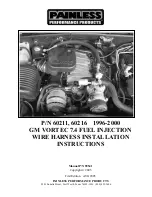
Tire Inflation Pressures
The proper cold tire inflation pressure is
listed on the driver's side B-Pillar or rear edge
of the driver's side door.
At least once a month:
• Check and adjust tire pressure with a good
quality pocket-type pressure gauge. Do not
make a visual judgement when determining
proper inflation. Tires may look properly
inflated even when they are under-inflated.
• Inspect tires for signs of tire wear or visible
damage.
CAUTION!
After inspecting or adjusting the tire pres-
sure, always reinstall the valve stem cap.
This will prevent moisture and dirt from
entering the valve stem, which could dam-
age the valve stem.
Inflation pressures specified on the placard
are always “cold tire inflation pressure”. Cold
tire inflation pressure is defined as the tire
pressure after the vehicle has not been driven
for at least three hours, or driven less than
1 mile (1.6 km) after sitting for a minimum of
three hours. The cold tire inflation pressure
must not exceed the maximum inflation pres-
sure molded into the tire sidewall.
Check tire pressures more often if subject to
a wide range of outdoor temperatures, as tire
pressures vary with temperature changes.
Tire pressures change by approximately 1 psi
(7 kPa) per 12°F (7°C) of air temperature
change. Keep this in mind when checking
tire pressure inside a garage, especially in the
Winter.
Example: If garage temperature = 68°F
(20°C) and the outside temperature = 32°F
(0°C) then the cold tire inflation pressure
should be increased by 3 psi (21 kPa), which
equals 1 psi (7 kPa) for every 12°F (7°C) for
this outside temperature condition.
Tire pressure may increase from 2 to 6 psi
(13 to 40 kPa) during operation. DO NOT
reduce this normal pressure build up or your
tire pressure will be too low.
Tire Pressures For High Speed Operation
The manufacturer advocates driving at safe
speeds and within posted speed limits.
Where speed limits or conditions are such
that the vehicle can be driven at high speeds,
maintaining correct tire inflation pressure is
very important. Increased tire pressure and
reduced vehicle loading may be required for
high-speed vehicle operation. Refer to your
authorized tire dealer or original equipment
vehicle dealer for recommended safe operat-
ing speeds, loading and cold tire inflation
pressures.
WARNING!
High speed driving with your vehicle under
maximum load is dangerous. The added
strain on your tires could cause them to
fail. You could have a serious collision. Do
not drive a vehicle loaded to the maximum
capacity at continuous speeds above
75 mph (120 km/h).
SERVICING
AND
MAINTENANCE
200
Содержание RAM CHASSIS CAB2018
Страница 6: ...4...
Страница 7: ...GRAPHICAL TABLE OF CONTENTS INSTRUMENT PANEL 6 INTERIOR 7 GRAPHICAL TABLE OF CONTENTS 5...
Страница 9: ...INTERIOR Interior 1 Door Locks Window Switches 2 Seats 3 Gear Selector 4 Switch Panel 5 Glovebox 7...
Страница 10: ...8...
Страница 39: ...CLIMATE CONTROLS Automatic Climate Controls With A Touchscreen Uconnect 4C 4C NAV Automatic Climate Controls 37...
Страница 40: ...Automatic Climate Control Knobs GETTING TO KNOW YOUR VEHICLE 38...
Страница 54: ...52...
Страница 72: ...70...
Страница 154: ...152...
Страница 174: ...172...
Страница 200: ...SERVICING AND MAINTENANCE 198...
Страница 222: ...220...
Страница 240: ...UCONNECT 4C 4C NAV WITH 8 4 INCH DISPLAY Uconnect 4C 4C NAV At A Glance Uconnect 4C NAV Radio Screen MULTIMEDIA 238...
Страница 284: ...282...
Страница 290: ...288...
Страница 298: ...296...
















































